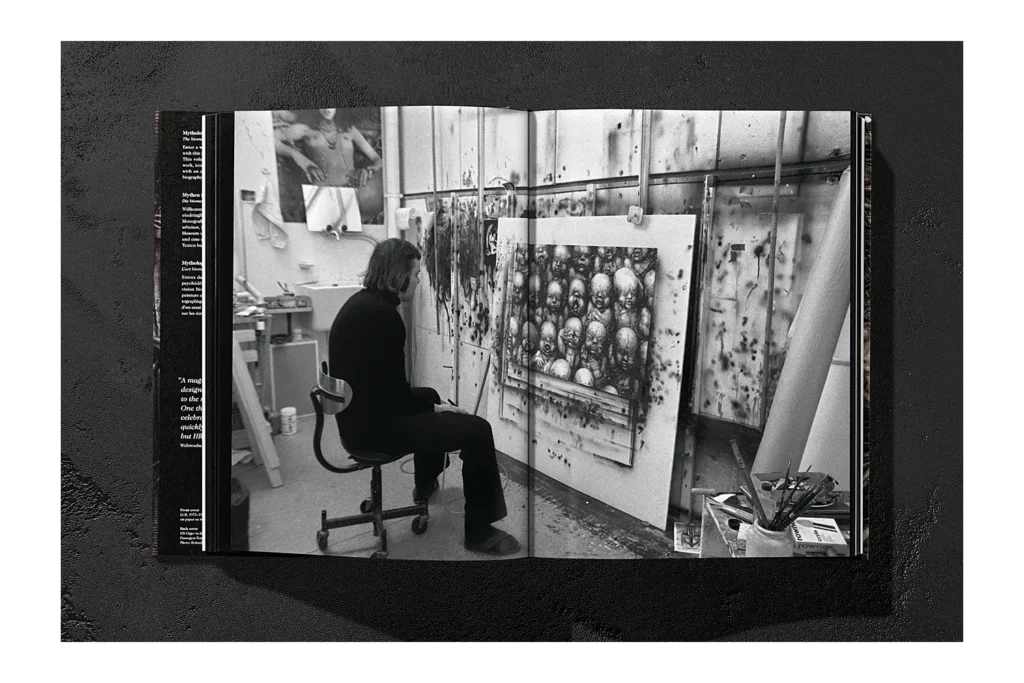The emergence of a new art style
The book “Myths for the Future ” sheds light on the work of Swiss artist HR Giger, who created an unmistakable aesthetic with his biomechanical style. By merging man and machine, he developed an image of a dystopian future that also captured the fears of his time. Early works such as the “Shafts” pictures thematise dream and trauma and allow the viewer to gaze into surreal abysses. Later works such as “Atomkinder ” show the confrontation with the nuclear threat and global fears. These themes run like a common thread through his work and make it a reflection of the technological and social challenges of his time.

© Taschen Verlag
Change between screen and film
In addition to his iconic screen works, Giger also achieved worldwide fame through his work for film. The transformation of his “Necronom IV ” into the deadly alien for Ridley Scott’s film of the same name set new standards in the design of creatures. Works such as “Gebärmaschine ” or the “Passagen-Tempel ” also show how intensively Giger dealt with birth, life and death. While his film figures often evoke horror and amazement, his sculptures such as the “Zodiac Fountain ” or the “Suitcase Baby ” invite the viewer to explore the duality of beauty and horror. This diversity of media emphasises Giger’s influence on various art movements.

© Taschen Verlag
Playing with mythology and dreams
The authors analyse the psychological and mythological levels in Giger’s work. Under the influence of Freud, Giger turned dreams and fears into central motifs. In “Under the Earth “, Giger shows mutations in a post-apocalyptic scenario that radiates both horror and a strange calm. Other works such as “Passagen-Tempel ” take up archetypal themes such as the metaphysical connection between birth and death. With these depictions, Giger expands the space between dream and reality, which often remains untouched in modern art. The book does not consider these themes in isolation, but as part of an oeuvre that is unrivalled in its complexity.

© Taschen Verlag
A legacy between art and technology
“HR Giger ” not only shows the breadth of Giger’s oeuvre, but also highlights his significance in modern art history. His biomechanical visions are on a par with the highly symbolic depictions of Hieronymus Bosch, who captured the fears and hopes of the Middle Ages. Giger transfers this theme to a future in which the boundaries between man and machine become blurred. Works such as “Necronom IV ” and the “Passagen-Tempel ” show how much Giger has influenced art beyond the boundaries of the classical medium. The book provides a deep insight into his work and encourages us to explore the relationship between art, technology and human existence in a new way.
Data
| Original title | HR Giger |
| Editor | Hans Werner Holzwarth |
| Author | Andreas J. Hirsch |
| Publisher | Taschen Verlag |
| Cover | Hardcover in a box |
| Pages | 506 pages, with numerous illustrations |
| Language | German, English, French |
| Dimensions | 29 x 39.5 cm |
| ISBN | 978-3-8365-7716-8 |
| Price | 175 € |
Further information
Further information on the book “HR Giger” (advertising) can be found on the Taschen Verlag website.
Compliance
The book was kindly made available to us by the publisher. The presentation and rating of HYPERMADE remains independent of this and is based solely on the content of the book.










